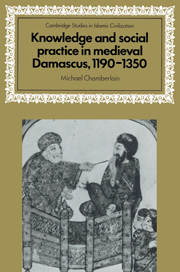Book contents
- Frontmatter
- Contents
- Preface
- List of abbreviations
- 1 Damascus and its surrounding region
- 2 Damascus in the thirteenth century
- Introduction
- 1 The acyān of Damascus, 590/1193–750/1350
- 2 Madrasas, the production of knowledge, and the reproduction of elites
- 3 Manṣabs and the logic of fitna
- 4 Social and cultural capital
- 5 Truth, error, and the struggle for social power
- Summary
- Bibliography
- Index
Introduction
Published online by Cambridge University Press: 06 November 2009
- Frontmatter
- Contents
- Preface
- List of abbreviations
- 1 Damascus and its surrounding region
- 2 Damascus in the thirteenth century
- Introduction
- 1 The acyān of Damascus, 590/1193–750/1350
- 2 Madrasas, the production of knowledge, and the reproduction of elites
- 3 Manṣabs and the logic of fitna
- 4 Social and cultural capital
- 5 Truth, error, and the struggle for social power
- Summary
- Bibliography
- Index
Summary
General statement of the problem
This book is about the social uses of learning in high medieval Damascus. The topic offers an opportunity to address two problems that historians of the period have puzzled over but not resolved.
The first arises out of the methodologies Western historians have applied to high medieval Islamic societies. Over the last two generations a number of historians have applied various methodologies of European social and institutional history to the period. The medieval Middle East would appear to be a suitable object of these approaches. The apparently undivided sovereignty of its rulers, the role of law in the regulation of its social life, the relatively high monetization of its economies, the existence of bureaucracies and large urban garrisons of standing armies – collectively these give the high medieval Middle East the characteristics of a highly complex and urban society on a par with early modern Europe. It should be not surprising perhaps that appearing frequently in studies of the period are familiar entities such as “government,” “the state,” “higher education,” “the army,” “bureaucracy,” and “administration.” Notions such as “dynastic legitimacy” and the distinction between the private and public spheres also find their way into the field. Historians often employ these concepts casually, but uncritical use has often put the field in danger of anachronism and confusion. Another problem with this approach is that it often leads historians to use “corruption,” “usurpation,” and “illegitimacy” as explanatory devices when the entities and institutions they study do not function as expected.
- Type
- Chapter
- Information
- Publisher: Cambridge University PressPrint publication year: 1995

